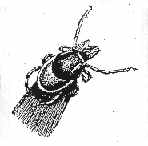 Host-finding of ambushing tick larvae
is achieved by a sequence of behavioural processes. We investigated the host cues that
stimulate the common cattle tick Boophilus microplus to performe the
questing-response. Under natural conditions, this behaviour pattern contributes to
localization, identification and invasion of the ticks bovine host. Our experiments in an
olfactometer-bioassay show, that apart from carbon dioxide, vibrations and light stimuli,
odourous components play an important role as releasing cues for questing behaviour.
Volatile components of cattle skin, which were obtained by absorbing them on polymerous
matrices, were highly attractive in our biotests. The active constituents were partially
identified by employing GC-MS and HPLC techniques combined with experimental observations.
We were able to equal the attractivness of natural odour with a artificial blend of pure
chemicals in the same concentrations as identified in natural odour substrates. Thus, the
olfactory stimulus could be characterized as a combination of several typical volatile
substances in distinct concentrations. B. microplus needs a bovine host for normal
development and egg-production rates. Immunological adaptations are mainly discussed as
explanation for this host-specificity. Several of our results indicate that different tick
species are able to differentiate between host- and non host-odours. B. microplus
discriminates between bovine and pig odour-substrates within a certain range of
concentration. In current studies with Ixodes ricinus, a tick species with a broader
host-spectrum and no pronounced host-specifity, we investigate the specificity of olfactory
orientation and our artificial "bovine" odour. Our results show that phenolic
odour fractions stimulated the questing response of B. microplus, but probably not
of I. ricinus.
Host-finding of ambushing tick larvae
is achieved by a sequence of behavioural processes. We investigated the host cues that
stimulate the common cattle tick Boophilus microplus to performe the
questing-response. Under natural conditions, this behaviour pattern contributes to
localization, identification and invasion of the ticks bovine host. Our experiments in an
olfactometer-bioassay show, that apart from carbon dioxide, vibrations and light stimuli,
odourous components play an important role as releasing cues for questing behaviour.
Volatile components of cattle skin, which were obtained by absorbing them on polymerous
matrices, were highly attractive in our biotests. The active constituents were partially
identified by employing GC-MS and HPLC techniques combined with experimental observations.
We were able to equal the attractivness of natural odour with a artificial blend of pure
chemicals in the same concentrations as identified in natural odour substrates. Thus, the
olfactory stimulus could be characterized as a combination of several typical volatile
substances in distinct concentrations. B. microplus needs a bovine host for normal
development and egg-production rates. Immunological adaptations are mainly discussed as
explanation for this host-specificity. Several of our results indicate that different tick
species are able to differentiate between host- and non host-odours. B. microplus
discriminates between bovine and pig odour-substrates within a certain range of
concentration. In current studies with Ixodes ricinus, a tick species with a broader
host-spectrum and no pronounced host-specifity, we investigate the specificity of olfactory
orientation and our artificial "bovine" odour. Our results show that phenolic
odour fractions stimulated the questing response of B. microplus, but probably not
of I. ricinus.Similarly, we studied the specificity of contact chemoorientation after changeover to a potential host. Preliminary results indicate an importance of lipophilic substances of bovine skin for orientation of B. microplus.